Dehlia Hannah‘s work traverses both the world of image-making and scientific discourse: she became interested in climate change and art around ten years ago and has repeatedly asked the question of how science frames the world aesthetically. Hannah uses philosophy and aesthetics to enrich her own thinking on issues such as climate change and global policies. She has become increasingly active in bringing her theoretical reflections on art and the environment into curation and critical discourse, recently venturing to Antarctica to review the Antarctic Biennale, co-curated by Nadim Samman, and designing art exhibitions for unusual contexts such as geo-engineering, science journalism and EU climate policy conferences. Her current research and curatorial endeavors center around the transmedia thought experiment A Year Without a Winter (2015-18). Berlin Art Link caught up with Hannah in Berlin during an epic thunderstorm-heat wave scenario: a fitting condition for a discussion about climate change.
Penny Rafferty: We are sitting through an assault of every weather condition possible— rain, hail, shine in a matter of minutes. It’s epic.
Dehlia Hannah: As usual, the atmosphere cooperates by putting on a show for me. [Laughing] In all seriousness, this it where begins, with talking about the weather. It’s supposed to be the most banal topic, but everyone knows that it’s how we talk about nothing and everything at once.. What the the sky’s doing, how you feel about it, whether you’re dressed for it— these are so many ways of ‘desiring the weather’ (to borrow an apt phrase from theorist Marita Sturken). You find out a lot about a person by seeing how they behave in the rain. I tend to run out in it. I love a good storm. But these days its become kind of a guilty pleasure.
Maybe this is why I’m drawn to art that amplifies atmospheric phenomena. Julius von Bismarck had an exhibition in New York this spring called ‘Good Weather’. He’s been out catching lightning bolts with rockets on the coast of Venezuela! I love this project because, like a lot of his work, it’s a performance of a kind of illicit desire with respect to nature. These kinds of desires, however insane or morally questionable, are actually what keep our attention riveted on what’s going on in our environments. Noticing is a prerequisite to questioning where we belong in that picture.
PR: That’s interesting because you see the same conflicts in the art world. Maybe it’s important to address the naysayers first. There’s been a lot of criticism of artists and art institutions for treating climate change as a greenwashing opportunity and exploiting it as a hot political topic, like feminism, racial injustice, queerness, etc. The art world is notorious for behaviour that swells the carbon footprint rather than reduces it—with art tourism, endless waste, an overproduction of printed matter. You must hear this argument a lot. How do you respond?
DH: I think there’s something right in those criticisms, and the ruthless drive for self-scrutiny is one of the strange virtues of the art world. But they don’t capture the whole picture. I take a lot of heat (sorry-climate puns are inevitable once you start!) for flying around constantly to work on climate change. But what worries me more than the geophysical cost of production of art and theory are concerns about how we’re shaping ideas of nature that, from a philosophical perspective, are the foundation of our response to environmental issues. Are beautiful images of melting glaciers (Caleb Cain Marcus, I’m looking at you) and ravaged industrial landscapes (Edward Burtynsky) aestheticizing the catastrophe and lulling us into a placid state of spectatorship? In fact, this possibility worried Edward Morris and Susannah Sayler, the founders of the ‘Canary Project’, an excellent platform for documentary photography about climate change since 2006. They’ve been known to exhibit photographs under a black shroud, with only the caption visible, forcing viewers to conjure the images for themselves, and thus perhaps engage more deeply with their significance. The question for me is, is the risk of wasted resources, self-congratulatory politics and hypocritical collusion with forces that drive climate change worth taking?
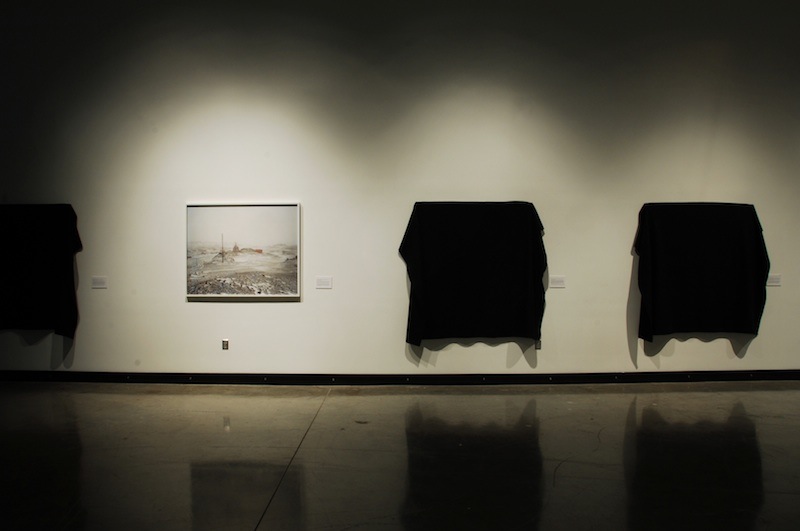
Edward Morris and Susannah Sayler: ‘A History of the Future’ Installation view Double Blind, Illges Gallery, Columbus, GA, 2010 // Courtesy of the artists
PR: Ok. And, on that note, successful scenarios?
DH: I don’t want to see art reduced to propaganda that needs to be clear, persuasive, and on message, although there are works that perform this function beautifully. One powerful thing that art can do is help people situate themselves imaginatively, emotionally and cognitively within their environment, to help produce what environmental psychologists call a ‘visceral fit’ between what we know and what we feel and sense directly. For example, Eve Mosher’s ‘High Water Line’ all of a sudden found new resonance after Hurricane Sandy, when New Yorkers recollected her performance of chalking out the flood plane for extreme storms that are expected to occur more frequently as climate change accelerates. (True confession: I rushed out to watch the toxic Gowanus Canal overflow and invited my friends over for Dark ‘n Stormy’s—my glee horribly tempered by the tragedies that followed). The use of fictional climate scenarios has also yielded some amazing work in speculative fashion and architecture, for example Anne van Galen’s collection of clothing designed to be worn in a world of endless rainfall, which is pretty easy to imagine in Copenhagen when we showed it there last year!
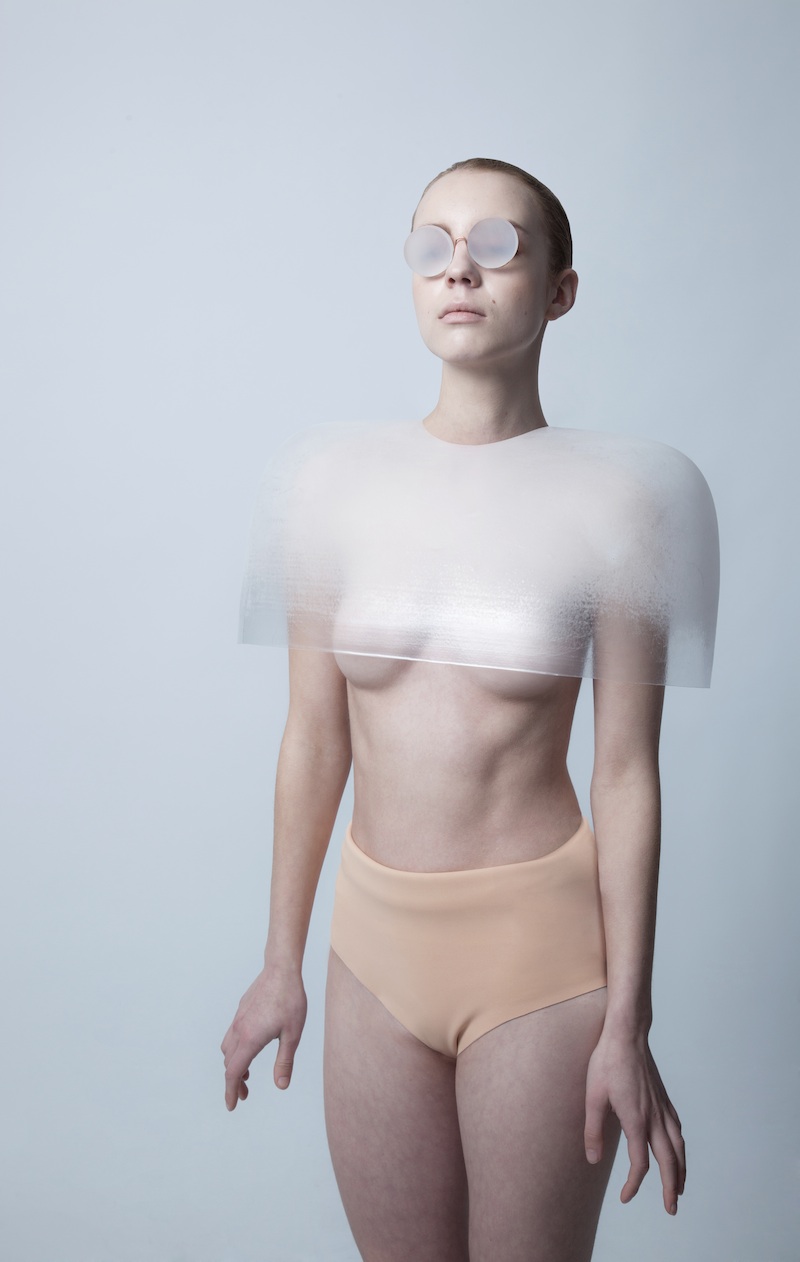
Anne van Galen: ‘Warriors of Downpour City’, 2014 // Courtesy of the artist
I’m drawn to works that feel diaphanous and immersive, works that usually don’t preach or teach at all. There’s been a profusion of installations involving fog and phase transitions, indoor rain, icebergs isolated from their surroundings (Olafur Eliasson, Random International, Tetsuo Kondo Architects). Kind of the opposite of Bismarck taming lightning outside, you see atmospheric processes made regular and artificial inside the white boxes of the art world, which read as scientific laboratories and clear rooms to my eye. To me, this kind of work suggests being inside the grid boxes of a climate model; they give some sense of where our knowledge of climate change is coming from. I guess what I’m after are conceptually precise but visually or sensually abstract interventions in our climatic imaginary.
Climate change is something that we know about only through the mediation of models and a vast socio-technological infrastructure for collecting and processing data. A visceral fit with that reality is hard to imagine. Karolina Sobecka’s work stands out to me as a compelling attempt to exhibit the atmosphere as a technosphere, for example by correlating human viewpoints with satellite images in ‘Clouds From Both Sides’. Recently she has stepped into the world of geo-engineering with ‘Cloud Services,’ a proposal for storing data inside the genomes of bacteria that affect cloud formation, a really provocative project that I’ve exhibited in a few different contexts recently. Really getting into the technical details, she’s precisely reconstructed the material composition of clouds that changed the course of history, such as a volcanic cloud produced by the eruption of Mount Tambora in 1815—the cloud at the center of my current project ‘A Year Without a Winter’.
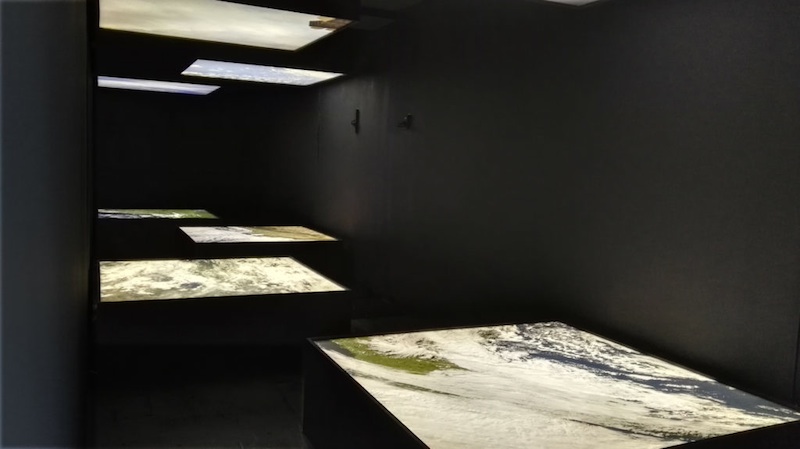
Karolina Sobecka: ‘Clouds From Both Sides’, Installation view, MU Art Space Eindhoven, 2016 // Photo: Hanneke Wetzer, courtesy of the artist
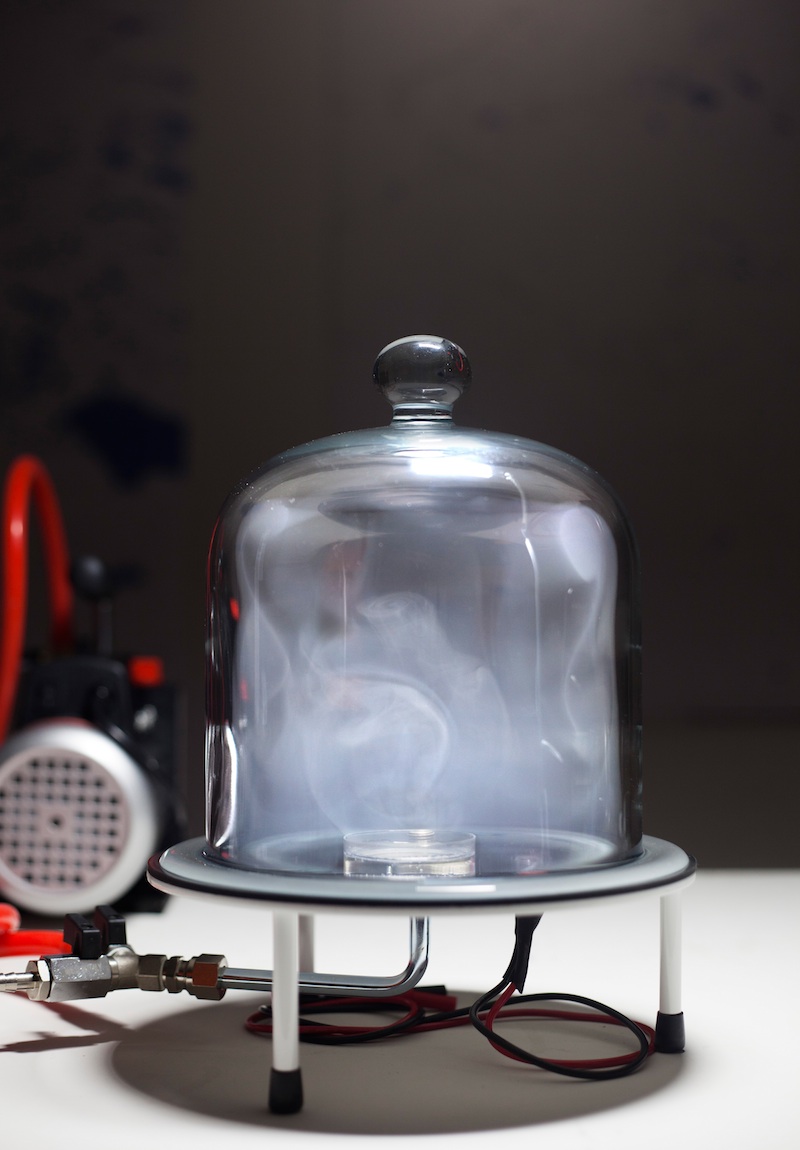
Karolina Sobecka: ‘Cloud A: A Memory’, 2017, Installation view, A Memory, an Ideal and a Proposition, Queens Museum, New York // Courtesy of the artist
PR: Speaking of challenging experience, I would also like to hear more about your trip to the Antarctic Biennale.
DH: I have to tell you the story of how I ended up going. I’ve been obsessed the idea of talking my way onto a boat to Antarctica for a while: maybe it was the Herzog movie, I don’t know. I was thrilled with the Antarctic Pavilion in Venice in 2015, where there was an installation by Alexander Ponomorev, a minimalist hull of a sunken ferry called Concordia, which addressed the fragility of the Antarctic Treaty. Later I met the pavilion’s curator, Nadim Samman, and heard about plans for a Biennale.
About two weeks before the ship was to leave from Ushuaia I was looking around the Armory Show in New York, feeling depressed by all the art crammed together into those tiny stalls, where its hard to take anything in, like a mall. I snapped a few pictures of things I liked and wanted to take time with properly somewhere else. A glass vitrine holding what looked a plant or a coral sheathed in ice totally delighted me—it brought back memories of the lacey ice crystals that formed on the windows at night when I was a child in Quebec City—but I couldn’t find the label to see who made it! That same night I heard from Samman that there would be a place for me on the boat if I could land a commission to review the Biennale for Frieze. #done. I met Julian Charrière on that trip and was halfway to Antarctica before we realized that the frozen sculpture I’d been admiring was his. Which was cool, because it turned out that the piece he’d actually made for the Biennale had been confiscated by the German police right before the trip—but that’s another story.
PR: The appeal of this trip—or trips like these—though, is that it could literally be a once in a lifetime experience right?
DH: Yes, I’m still reeling. It felt like an avalanche of coincidences propelling us all there, together, just then. It was pure magic, but since I don’t believe in magic I’m still working through what it all means sober. The pressure was immense. Knowing that we’d probably never get to come back and that Antarctica itself might not be intact even if we did, I felt a duty to allow myself to be transformed by the experience. Right before we left came news that there was an immense crack in the West Antarctic Ice Shelf. When it breaks off (like a chunk of the Larsen C did just last week) the effects will be felt around the world—sea level rise, salt and fresh water mixing and disturbing ocean and air currents, feedback loops… The Biennale wasn’t about climate change but because of it, we were hyperaware of our presence in this beautiful, precarious, remote, and also elite site. It was like boot camp for environmental sensing—training for the kind of awareness we actually need to have everywhere in the world.
It occurs to me only now that the idea of a plant surrounded by ice is part of the imaginary landscape that the Biennale left me with. Paul Rosero Contreras had been cultivating a cacao plant to survive at cold temperatures and he brought it from Ecuador to an icy slope where millions of years ago Antarctica had a tropical climate, which it might in the foreseeable future as well. Even in its terrarium the sight of a plant in Antarctica is haunting—its rarity, the fragility of the environment that enables it to survive here and at home, the threat this flash of green poses to the ice continent as an invasive species, a proxy for ourselves. When, after many negotiations, the plant was finally installed in Paradise Bay, Paul spontaneously fell down on his knees in front of it with tears in his eyes, like he was praying. It was just one of the many moments that, to be honest, I felt a kind of euphoria at being awake in the face of what I think is an imminent tragedy. A paradoxical response—I’m not trying to justify it, just to sit with it.
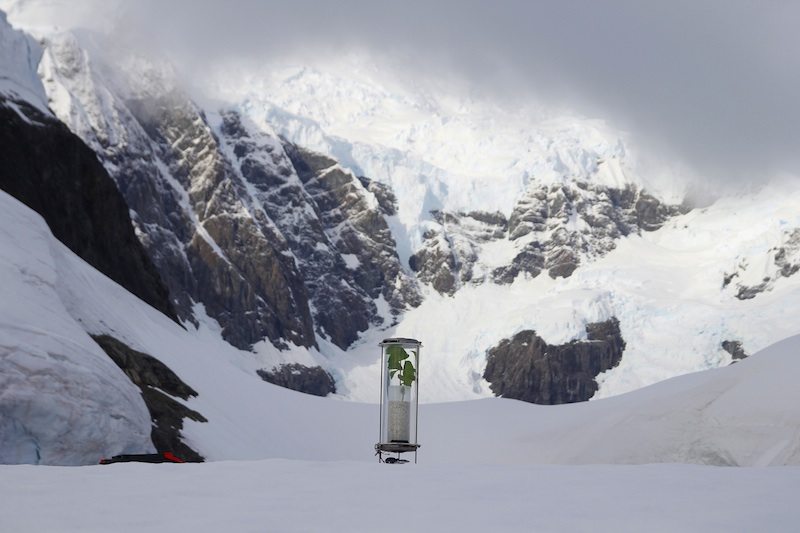
Paul Rosero Contreras: ‘Arriba!’, Installation View, Antarctic Biennale, 2017 // Courtesy of the artist
PR: It seems in many of the examples you have given, artists themselves are very earnest in the way they wish to draw attention to political issues, but the infrastructure surrounding them is less pragmatic. One example that was much contested was the sponsorship deals between the Tate and BP: this has been resolved, but only by BP withdrawing from the Tate rather than the Tate denouncing them. How do we address problems like this, so we can move on?
DH: Well, my intuition is to get into the belly of the beast and engage. My dream is to do an art exhibition on one of those decommissioned oil rigs that’s rusting away in the Arctic because climate change is making it too risky to drill!






















